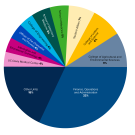We know the best ideas for fixing our bottom line often come from staff and faculty on the front lines — whether you work in a classroom, office, lab, field, hospital, or water treatment plant.
In 2022, Provost Mary Croughan gathered representatives from all corners of UC Davis to create the Revenue Generation and Institutional Savings Task Force. The task force was charged with identifying at least $50 million in ongoing net revenue and/or savings that can be applied to the campus core mission within 3-7 years to help address UC Davis' core funds deficit.
IDEA$ at Work campaign
To help meet this goal, the task force sought to collect suggestions from UC Davis employees that could assist the university’s long-term financial stability — with the goal of at least 1,000 ideas before the end of fiscal year 2022-23.
The IDEA$ at Work campaign launched in November 2022, inviting faculty, academics and staff from across the Davis and Sacramento campuses to share insights from their work for cost savings, new revenue opportunities or efficiency improvements. Employees were encouraged to submit all ideas, large or small, with an online process that allowed for anonymous submissions, prizes and other incentives to participate.
Task force analysis and report
Members of the Revenue Generation and Institutional Savings Task Force engaged a team of students in the UC Davis Graduate School of Management Impact Program to help develop a process and evaluation tool to assist the task force with reviewing and rating the many ideas submitted to the IDEA$ at Work campaign.
Every idea submitted was individually read, reviewed and rated by one of seven task force committees, with a shared rating process to help calibrate ratings between the committees. Committees grouped some related ideas into themes to be assessed. Once ideas and themes were rated, committees discussed the individual metric scores and total weighted priority score. They discussed potential adjustments, synergies and other insights.
In June 2023, the task force released its recommendations and final report (PDF). The 22-page report identifies key themes and recommendations; discusses the evaluation process; and includes attachments with additional information.

